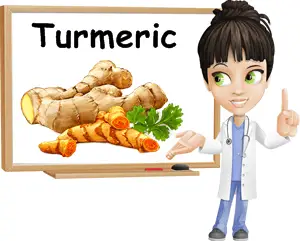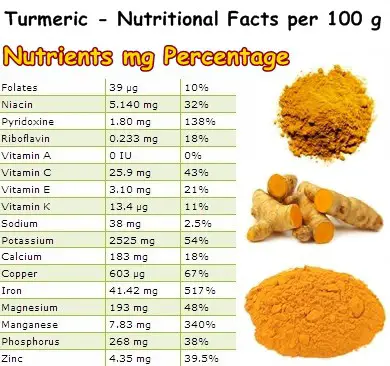A member of the ginger family, turmeric (Curcuma longa) boasts exceptional healing properties and has been an important part of traditional Indian and Chinese medicine for thousands of years and continues to do so. The spice is a exceptional source of vitamin B6, B3, B2, C and E, copper, iron, manganese, potassium, magnesium, phosphorus and zinc, but contributes to daily vitamin and mineral requirements with only small amounts since intake is limited. At the same time, turmeric has active ingredients with strong antimicrobial, antioxidant and anti-inflammatory effects.
Turmeric appears to have such incredible health benefits that the Indian people have used it as a miracle-remedy for an surprisingly wide range of medical conditions, from infections and open wounds to skin and pulmonary problems and even tumors. Interesting enough, ongoing medical trials appear to support the idea that turmeric is an unbelievably potent antibacterial, anti-inflammatory and anticancer food with the potential for a variety of therapeutic applications.

Turmeric is extensively cultivated in the southern parts of the Asian continent for both culinary and medicinal purposes and is thus both a spice and a medicinal herb. The plant loves rain and sunshine and can grow to a height of about 1 meter. The part of the plant used for culinary and medicinal purposes is the root, which is not actually a true root, but a modified underground stem called a rhizome. Turmeric root can be used fresh or dried and is available whole or ground. Turmeric powder boasts a range of topical uses for skincare and is also available in supplement form for various therapeutic uses.
What does turmeric look like?
Turmeric roots have a thick, cylindrical, but asymmetrical build with nodes or protuberances and are relatively similar in appearance to ginger root. The flesh ranges in color from a deep golden-yellow to orange, but the skin is a dull grayish-brown. Fresh roots are crisp and particularly aromatic, although not as much as dried, ground turmeric.
What does turmeric taste like?
Turmeric roots are sharp, spicy, pungent and fragrant with a slight bitter aftertaste. The best way to describe the taste of turmeric is a warm, peppery flavor with earthy flavor notes. If consumed in small amounts at once, it offers a pleasant taste experience. Eating too much at once can prove overwhelming.
Active compound in turmeric
Curcumin is the main biologically active compound in the spice. It is a natural phenol found in turmeric and is responsible for the plant’s yellow pigmentation as well as therapeutic properties. Scientists believe curcumin to be an incredibly effective antiarthritic, antioxidant, anticancer, as well as anti-inflammatory, anti-amyloid and anti-ischemic agent. Preliminary laboratory research and existing studies appear to support some of the claims regarding the therapeutic activity of turmeric and reveal reasonable intakes are conducive to good health.
Traditional medicinal uses of the spice from ancient Chinese and Indian medicinal systems are thus being given more thought as turmeric is presently being considered as a stepping stone in the development of novelty treatments for some of the most severe afflictions such as arthritis, cancer, Alzheimer’s Disease and coronary heart disease.

Nutrition facts and benefits of Turmeric
Turmeric is cholesterol-free and boasts a high dietary fiber content. Dietary fiber helps reduce LDL (bad) cholesterol levels, relieves constipation and promotes easy, regular bowel movements. However, because you can only eat very small amounts of the root (amounts normally used to season food), fiber intake from turmeric produces no visible benefits. In addition to this, the root is spicy and thus a source of side effects for anyone with hemorrhoids, if eaten in large amounts.
Also see these 5 reasons turmeric is bad for you.
Valuable essential oils such as curcumin, curlone, curumene, cineole, turmerone, p-cymene and germacrone give turmeric its particular flavor and provide antioxidant, antibacterial, antifungal and even antiviral and antiparasitic benefits. However, curcumin is the main active ingredient in turmeric and the principal source of turmeric health benefits and side effects.
The spicy root is a great source of vitamins and minerals. For instance, 100 g of fresh turmeric provides 138% of the recommended daily allowance of pyridoxine, or vitamin B6. It also contains moderate amounts of niacin, folate and riboflavin, B-group vitamins that, among other things, ensure the proper distribution of energy throughout the body.
Also, turmeric has generous amounts of vitamin C, a potent antioxidant-vitamin with amazing anti-inflammatory and antibacterial properties. Vitamin C not only boosts immunity and offers protection against bacterial infections, but also counteracts the harmful effects of free radicals and promotes collagen production. Last but not least, vitamin E ensures beautiful, radiant skin.

As far as minerals are concerned, turmeric boasts an incredible iron content: 517% of the recommended daily intake. Iron is an essential component for the production of red blood cells, playing a crucial role in the prevention of anemia. The spice also contains more than generous amounts of manganese: 340% of the RDI, recommended daily intake. Manganese is a mineral with potent antioxidant effects (to be more precise, it is a crucial co-factor for the superoxide dismutase enzyme, a sort of natural antioxidant defense of our body).
Turmeric is a rich source of zinc, phosphorus, magnesium, copper, calcium and potassium as well. While zinc is important for enhancing the immune activity of the body, magnesium optimizes both calcium and potassium absorption.
Also, magnesium promotes healthy muscles (heart-included) and his fellow mineral, potassium, regulates body fluids and heart pressure. For further information on vitamins and minerals and their health benefits, see our vitamins and minerals page.
Conclusion
Overall, turmeric is a wonderfully aromatic spice, modestly nutritious and a source of important health benefits. Due to its strong antioxidant and anti-inflammatory activity, it is believed play a role in the prevention of Alzheimer’s disease, heart disease and infections as well as hold anti-tumor properties. Whether you prefer to purchase it at from your local supermarket or grow it yourself (which is always a good idea), turmeric can have positive effects on your health. Revered by both ancient Chinese and Indian traditional medicinal systems, turmeric has caught the eye of modern medicine as well.
